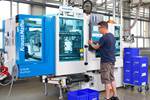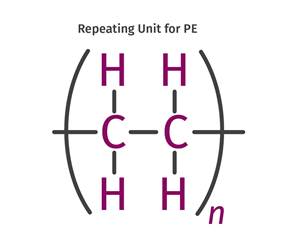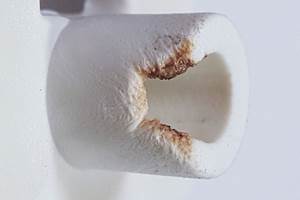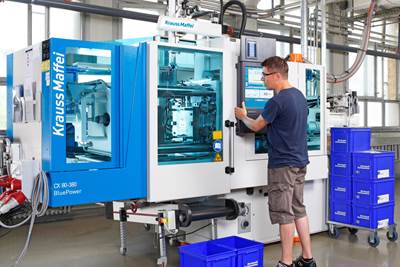Through Thick and Thin: Reflecting on Injection Molding Thin and Thick Walls
Author considers time molding thin-wall food packaging and thicker-walled interior automotive trim, weighing the differences and similarities in process, molds and materials.
Since I first started working in food packaging, I have been asked, and sometimes told, how much more complex thin-wall molding is compared to other subsets in the injection molding industry. I always found it a bit comical because the laws of physics don’t change based on how thin a side wall is on a container. In fact, the one thing I like to point out in the food packaging industry is that polyolefin materials follow all the rules, unlike many types of engineering grade resins. This significantly improves our chances of predicting how process changes will impact part characteristics.

Thin-wall molding common rigid food packaging poses many potential processing pitfalls. Source: Netstal
I have run materials that cause the parts to increase in size after they have been demolded, and materials that if heated an additional 50°F will expand 1,000 times their size. At least with polyolefins, we can often know what we’ll get by increasing the barrel temperatures or decreasing the cooling, at least with a standard non-filled resin.
Each of the subsets in our industry has complexities of its own, and each one requires learning and experience to master.
For this article, I thought it would be interesting to compare rigid food packaging to automotive interior molding, since they are the industries in which I have spent the majority of my 31 years in injection molding.
Cycle Time Rules All
The biggest issue is simple — cycle time — which makes complete sense. In rigid food packaging, we are running a 48-oz. container with an overall wall thickness of .024 inch out of polypropylene (PP) with a mold temperature of 50°F. It should be no surprise that the 6-second cycle time is just a fraction of the time we used to mold a steering wheel bezel with a .150-inch wall thickness out of PC/ABS with a Class A surface and requiring a mold temperature of 150°F.
Now the obvious point here is that it’s going to take a much longer mold-closed time to cool the thicker parts, but it also takes longer due to the mold temperature and the temperature of the plastic. “Less heat in/less heat out” is the adage I’m sure we’ve all heard at some point, and it is absolutely true. PC/ABS runs at hotter melt temperatures, so even if we were using it in the same mold, it would still take longer to cool the parts compared to a PP.
So usually if someone asks me the “what’s-harder-thick-vs.-thin” question, I go to the cycle-time answer. However, this is not me saying that thin-wall molding is more difficult or complex, it is just faster. I think it’s human nature to want to think that what you’re doing takes more ability or is more difficult than what others are doing. Ultimately, each of the subsets in our industry has complexities of its own, and each one requires learning and experience to master. Regardless of the market, we are all still focusing on the same four plastic variables: heat, speed, pressure and time.
As opposed to a mold for automotive interior trim that might have two or four cavities, rigid food packaging molds are usually multicavity stack molds. It’s easy for someone who has never run an interior trim automotive mold to assume that operating a two-cavity mold can’t be anywhere near as difficult as running a 96-cavity multilevel lid mold. That depends on what is going on inside that two-cavity mold. One of the most difficult molds I ever had to run was a single-cavity mold with so many moving components that the slightest mistake caused a crash.
I’m just making a point that injection molding, regardless of the industry or the customer, requires skill and critical thinking. You really can’t, nor should, generalize.

Most interior automotive trim components feature Class A surface finishes requiring forethought on design elements like gate location. Source: Engel
Feeling the Pressure
Thin-wall molding typically requires high injection pressures to fill those thinner walls, which can push many machines to the edge of being pressure limited. It’s not uncommon to have a fill pressure exceeding 25,000 psi with fill times that are under .25 second. Because of the thin walls, the flow length is much more critical than in thicker products. With thin walls, using too much hold pressure — or any hold pressure in some cases — can cause parts to warp because of molded-in stress. Every tenth of a second counts in this world. Fill speeds are increased to inject as fast as possible and produce a good part, and it’s not done for any other reason than to get as much time out of the cycle as possible.
Interior trim automotive molding with Class A surface finishes most often needs hotter mold temperatures in the cavities. This can help with hiding defects like gate blemishes, or if we are running glass-filled resin, it helps the plastic migrate to the surface to hide the fibers. Part design is critical for cosmetic reasons like hiding the gate and ensuring the heat from the plastic entering the cavity forming steel doesn’t cause a visual defect. Running melt temperatures that don’t impact the color is another factor. Too hot and a beige will turn slightly red, while too cold and it turns slightly green.
Plastic injection molding is a science, and that science is the same regardless of what end market you’re in or what part you’re molding.
Tangent: It’s impossible to adequately express my frustration when dealing with color and automotive parts. I once had a customer tell me that the black part I had just molded was too green. Never mind the part’s color, my face was red as I did my best to fight back my natural response after spending hours to eliminate a gate blemish due to the part being gated in a bad location.
These are just a few examples of differences in the worlds of these two industries. They both have challenges that training can help with but require experience to understand and master. That said, plastic injection molding is a science, and that science is the same regardless of what end market you’re in or what part you’re molding.
About the Author: Robert Gattshall has more than 31 years of experience in the injection molding industry and holds multiple certifications in Scientific Injection Molding and the tools of Lean Six Sigma. Gattshall has developed several “Best in Class” Poka-Yoke systems with third-party production and process monitoring suppliers such as Intouch Monitoring Ltd. and RJG Inc. He has held multiple management and engineering positions throughout the industry in automotive, medical, electrical and packaging production. Gattshall is also a member of the Plastics Industry Association’s Public Policy Committee. He is currently the molding engineering manager at Amcor. Contact: 262-909-5648; rgattshall@gmail.com.
Related Content
Process Monitoring or Production Monitoring — Why Not Both?
Molders looking to both monitor an injection molding process effectively and manage production can definitely do both with tools available today, but the question is how best to tackle these twin challenges.
Read MoreThe Fundamentals of Polyethylene – Part 2: Density and Molecular Weight
PE properties can be adjusted either by changing the molecular weight or by altering the density. While this increases the possible combinations of properties, it also requires that the specification for the material be precise.
Read MoreBack to Basics on Mold Venting (Part 1)
Here’s what you need to know to improve the quality of your parts and to protect your molds.
Read MoreHow to Select the Right Cooling Stack for Sheet
First, remember there is no universal cooling-roll stack. And be sure to take into account the specific heat of the polymer you are processing.
Read MoreRead Next
Understanding—and Using—Decompression to Your Advantage
Decompression—aka suckback—is a very important setting on an injection molding machine. On today’s machines, molders typically get the option to set decompression before and after screw rotation/recovery. Are they using this feature to their advantage?
Read MoreStarting or Restarting an Injection Molding Machine — What Works Best?
Successfully starting or restarting an injection molding machine is less about ticking boxes on a rote checklist and more about individually assessing each processing scenario and its unique variables.
Read MoreIs It Time For Injection Molding Machines to be Standardized?
If you looked at four machines from four different suppliers, you’ll find four different sets of icons and terminologies, all in different layouts.
Read More












